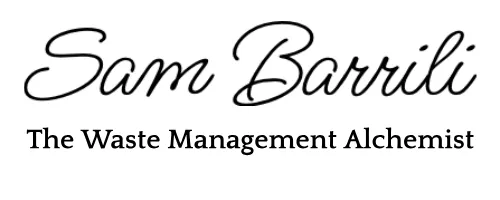Articles

The $117 Billion Opportunity Hiding in America’s Trash—And How Smart Manufacturers Are Cashing In
For decades, secondary raw materials have been viewed as mere substitutes—a way to cut costs, a fallback when virgin resources became too expensive or scarce.
But for the first time in history, these materials are stepping into the limelight, not as an alternative, but as a primary asset fueling the resurgence of American manufacturing. And if you’re not paying attention, you’re about to miss the biggest shift in industrial economics since the rise of mass production.
[Download the eBook “Thriving With Waste”]
The Turning Point: Why Local Production Needs a New Raw Material Supply Chain
The economic landscape in the United States is changing fast. New tariffs imposed on imported goods, including automobiles and electronics, are forcing major global manufacturers to rethink their supply chains. Companies like Mercedes-Benz have already announced plans to move more of their production to the U.S., avoiding import duties and reducing dependency on unpredictable international trade policies.
With this shift, one unavoidable reality emerges: the need for raw materials is about to explode. More factories on U.S. soil mean more demand for the metals, plastics, and industrial inputs that fuel production. Historically, these materials have been sourced from overseas markets, mined from the ground, or refined through energy-intensive processes. But that’s where the game is changing.
[Download the eBook “Thriving With Waste”]
The Rise of Secondary Raw Materials as a Core Economic Driver
Here’s the simple truth: the modern American economy is sitting on an untapped goldmine—billions of tons of valuable raw materials already circulating within its borders. The scrap from old automobiles, the remnants of consumer electronics, the discarded industrial waste from manufacturing processes—these materials contain the exact same essential inputs that manufacturers have been importing for decades. The only difference? Now, they’re becoming the first choice, not the last resort.
For years, secondary raw materials were seen as a backup plan, a way for businesses to claim they were "recycling" while still depending primarily on traditional resource extraction. But the growing cost of importing materials, combined with logistical bottlenecks and international market instability, has flipped the script.
Companies can no longer afford to treat recycled materials as an afterthought. They need a stable, cost-effective, and immediately available supply chain, and the answer is right in front of them. The U.S. is primed to harness its own industrial waste streams, transforming what was once considered disposable into a core component of large-scale manufacturing.
[Download the eBook “Thriving With Waste”]
The Economics of Secondary Raw Materials: Why This Is No Longer Just "A Good Idea"
If you’re an industrial leader, an investor, or even an entrepreneur looking for the next big play, listen closely. The numbers behind this shift are staggering:
The U.S. scrap industry alone generates over $117 billion annually
Aluminum recycling requires 95% less energy than producing aluminum from virgin ore
Steel mills are now increasingly relying on domestic scrap sources, reducing costs and enhancing production efficiency
The secondary plastics market is projected to hit $55 billion by 2027
This isn’t just about saving a few dollars. This is about reshaping the foundation of manufacturing. Secondary raw materials are providing companies with a way to insulate themselves from volatile global commodity prices, ensuring a consistent and affordable supply of essential materials without the risks of international trade disputes, political instability, or shipping delays.
[Download the eBook “Thriving With Waste”]
The Winners and Losers in This New Industrial Revolution
Make no mistake—this shift will create winners and losers.
The winners? Companies that recognize the power of secondary raw materials early and integrate them into their production models. Manufacturers that invest in advanced processing facilities, forge partnerships with material recovery firms, and build strategic supply chains around reclaimed resources will dominate the next industrial era.
The losers? The businesses that fail to adapt. The ones still clinging to outdated notions of resource acquisition, waiting for international markets to stabilize, or assuming that secondary raw materials are still a "second-rate" option. They’ll be left behind as more agile competitors secure cost-effective materials right from their own backyard.
[Download the eBook “Thriving With Waste”]
How America Can Lead the Charge in Large-Scale Production Using Secondary Raw Materials
This isn’t just a passing trend. This is a fundamental shift in how goods are made, and the U.S. is in the perfect position to lead the charge.
Localizing Material Recovery Infrastructure
Companies that embrace domestic material processing hubs will reduce costs and ensure consistent supply chains.
Cities and states that invest in industrial-scale material recovery facilities will attract manufacturers looking for stable raw material sources.
Building Corporate-Driven Supply Networks
Smart businesses are already forging direct partnerships with scrap processors, electronic waste recovery firms, and metal refiners to secure a steady stream of secondary raw materials.
Auto manufacturers, for example, can establish direct recovery programs, ensuring that scrapped vehicles feed directly back into the production of new ones.
Leveraging Technological Advancements
Innovations in material separation, chemical processing, and AI-driven sorting are making it easier than ever to extract high-purity materials from industrial waste streams.
Companies investing in cutting-edge recycling technology will gain a competitive advantage, reducing dependency on traditional mining and refining operations.
[Download the eBook “Thriving With Waste”]
The Bottom Line: Secondary Raw Materials Are the Key to Economic Independence
The U.S. manufacturing sector is on the brink of a massive transformation, and secondary raw materials are at the heart of it. This is no longer about "doing the right thing." This is about economic survival, industrial dominance, and the creation of an entirely new market that will determine the next generation of manufacturing powerhouses.
The only question is: Will you be ahead of the curve, or will you be playing catch-up when the industrial landscape has already changed?
It’s time to stop thinking of secondary raw materials as a fallback option. They are the future. And for those who move fast, the opportunities are limitless.
Welcome to the new age of American manufacturing.
To Your Success
Sam Barrili
The Waste Management Alchemist


Sam Barrili
I'm known as the go-to guy for talking about business strategies and growth strategies for waste management companies.
I started my journey in this field in 2009 when I finished my degree in Toxicological Chemistry and joined a wastewater treatment company to develop its market.
Since then, I helped dozens of waste management companies in America and Europe increase their annual profits by over 25 million dollars thanks to my SAM Method.
If you want to know if I'm a good fit for you, read an article or watch a video.
If you find it helpful, I’m probably a good match.
If not, that's OK too.
Call +1 (801) 804-5730
Email: [email protected]

